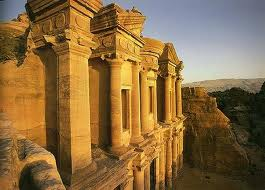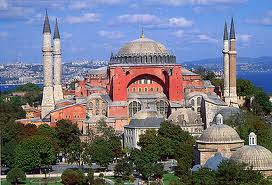|
The Byzantine religious architecture was distinctive for the absence of decoration with statues which was forbidden. The inner walls were decorated with splendid mosaics, mostly of colored glass. The mosaics predominantly decorated the apses, ceilings and walls above the columns. The best example is the St Mark’s Basilica in Venice, Italy, built in the Byzantine style and covered with more than 8,000 square meters of mosaics.
Byzantine and Islamic architecture share a common trend: that is, the use of the dome. One example is the Dome of the Rock in Jerusalem, which was Islamic architecture, but illustrates the influence Byzantine bestowed as the dome style passed on to the Muslims. They often used "Persian' dome.

We modernly refer to this as the Onion Dome. The most celebrated example is the Taj Mahal (A.D. 1630) at Agra, India. Byzantine's advancement in developing the dome created a new style in global architecture, for no other civilization had designed buildings, especially religious buildings, as did the Byzantines.
The most imposing achievement of Byzantine architecture is the Church of Holy Wisdom or Hagia Sophia. It was constructed in a short span of five years (532–37) during the reign of Justinian. Hagia Sophia is without a clear antecedent in the architecture of late antiquity, yet it must be accounted as culminating several centuries of experimentation toward the realization of a unified space of monumental dimensions.

Throughout the history of Byzantine religious architecture, the centrally planned structure continued in favour. Such structures, which may show considerable variation in plan, have in common the predominance of a central domed space, flanked and partly sustained by smaller domes and half-domes spanning peripheral spaces.
Justinian's reign is distinguished by an exceptional record of architectural and artistic patronage and production. Following the Nika Riot of 532, the emperor initiated a program of urban construction that aimed to remake the ancient capital founded by Constantine the Great in 324. Along with tremendous patronage in monumental building and decoration, the portable arts also flourished during the age of Justinian.

The Basilica of San Vitale in Ravenna contains two precious mosaics from the golden period of the Byzantine art and architecture. The first mosaic depicts the Byzantine Emperor Justinian I with his retinue on golden background.
Euphrasian basilica was raised in the 6th century, during the period of emperor Justinian and bishop Euphrasius, who it was named after. The pontifical complex was preserved entirely, which is a rarity in architecture of that period.
|

![]()


